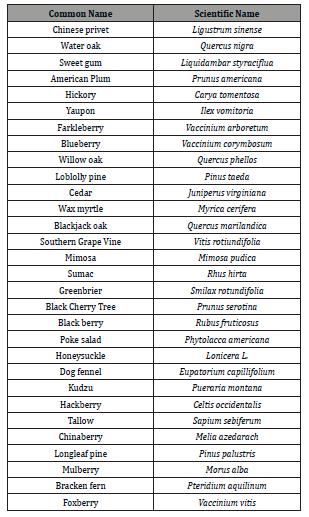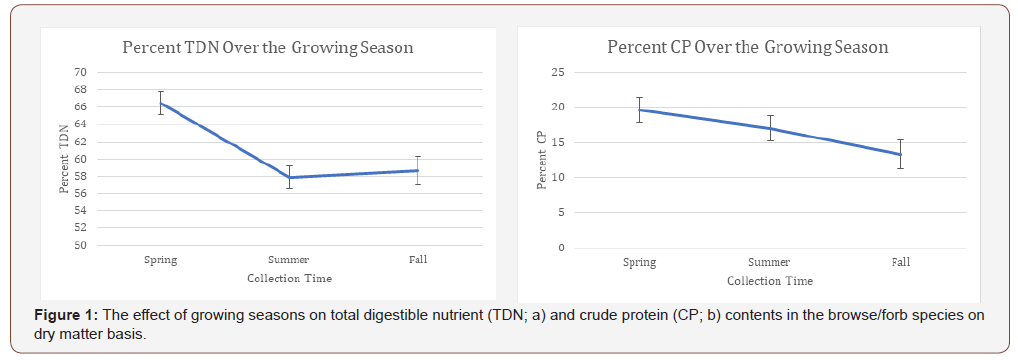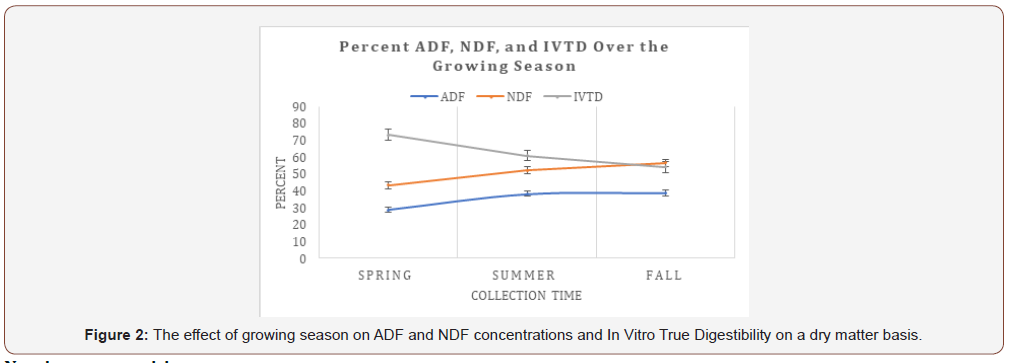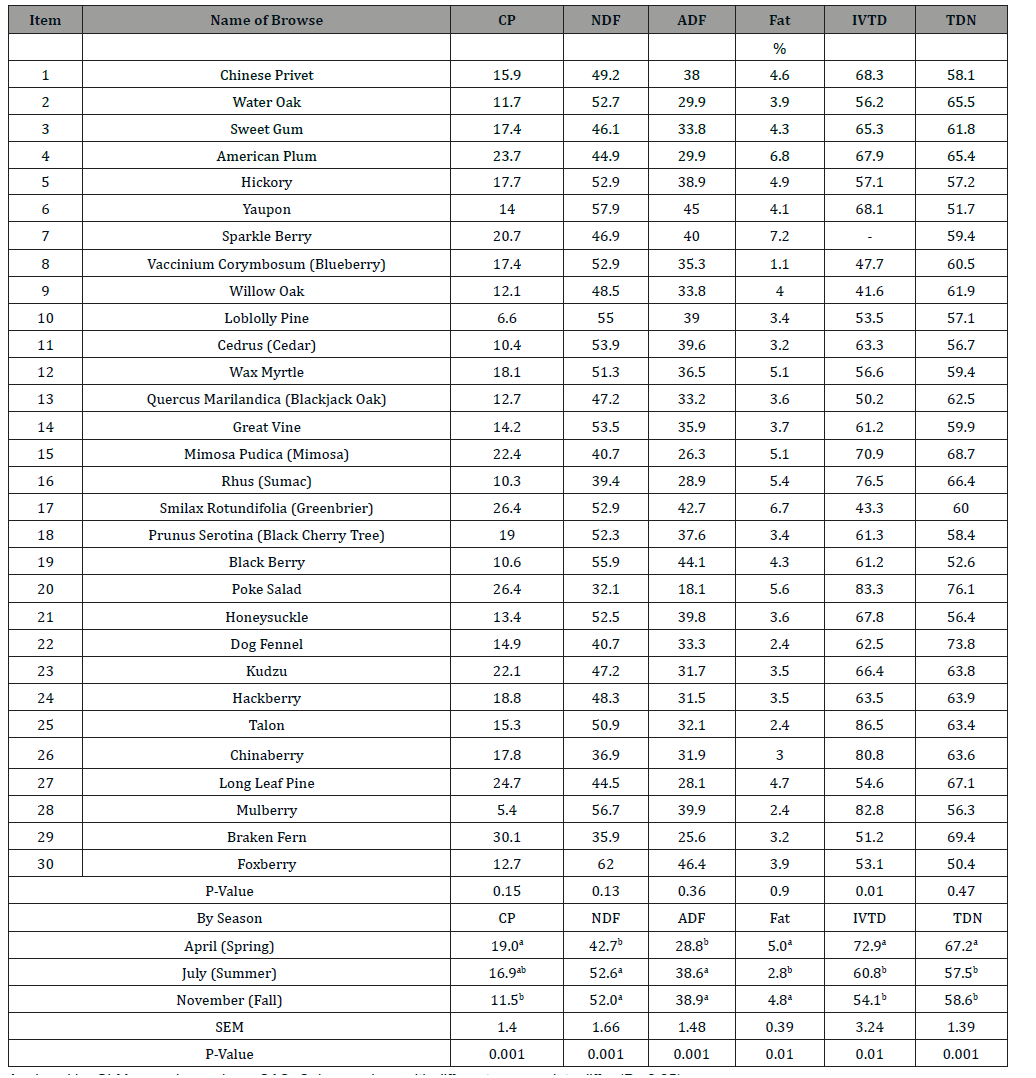 Research Article
Research Article
The Effect of Growing Season on the Nutrient Composition and in Vitro True Digestibility of Browse and Forb Species Commonly Consumed by Goats in the Southeastern United States
Frank Abrahamsen1, Briana Epps2, Nar Gurung2* and Ronald Smith2
1Department of Pathobiology, College of Veterinary Medicine, Tuskegee University, USA
2Department of Agricultural and Environmental Sciences, Tuskegee University, USA
Nar Gurung, Department of Agricultural and Environmental Sciences, Tuskegee University, 103 Mary Starke Harper Hall, Tuskegee, USA
Received Date: August 21, 2019; Published Date: August 23, 2019
Abstract
The goal of the study was to determine the nutritive values and in vitro true digestibility (IVTD) of browse and forb species consumed by goats at the Tuskegee University Atkins site. The site can be described as unmanaged long leaf pine plantation site approximately 10 years of age in the east, gulf coast region of Macon County, Alabama. The latitude of the Tuskegee site is 32.4230N and longitude is 85.6910W. The landscape is characterized by gently sloping topography (5–10 percent) and consist of many encroaching browse/forb species. The predominant grass cover is primarily of Andropogon virginicus (broom sedge) and other bunch grasses. These browse/forb species encompass much of the woodland vegetation in the Southeastern United States. Thirty different species were selected for analysis based on previous observations of goat preferences. Samples consisted of the leaves and tender tips collected three different times throughout the duration of the growing season (i.e. April (Spring), July (Summer), and November (Fall)). Samples were analyzed for crude protein (CP), acid detergent fiber (ADF), neutral detergent fiber (NDF), crude fat, and in vitro true digestibility (IVTD). The total digestible nutrients (TDN) values were estimated from ADF values. The average CP values were 19.0, 16.9, and 11.5% for spring, summer and fall collections, respectively. There were significant differences (P<0.001) between the spring values compared with summer and fall values, however, there were no differences (P>0.05) between the summer and the fall values. Similar trends were observed for ADF, NDF, TDN, and IVTD values, except the fat values were similar between the spring and the fall collections while being significantly different from the summer values (P<0.01). The results provided valuable information about the nutritive values and IVTD value of browse and forb species commonly consumed by meat goats in the woodland areas of Alabama. The experiment will be continued for two additional years to overcome the seasonal differences so meaningful results can be obtained.
Keywords:Browse; Forbs; Nutritive values; In vitro true digestibility
Abbreviations:CP= Crude Protein; ADF= Acid Detergent Fiber; NDF= Neutral Detergent Fiber; TDN= Total Digestible Nutrients; IVTD= In Vitro True Digestibility; CT= Condensed Tannins
Introduction
Much of the woodland vegetation in the Southeastern United States consists of many browse and forb species. This vegetation can be a valuable feed resource for goats because given the choice goats consume largely browse species (73%), and lesser amounts of grasses (23%) and forbs (4%) [1]. Goats have consistently shown to consume a wide variety of plants and selected higher quality plants than cattle and sheep [2].
Goat production in the Southeastern United States is becoming increasingly more important as the population is becoming more diverse, diversifying the market demands for livestock products (i.e. meat and milk). Currently, goats, which are naturally browsers are being reared in grazing systems which are not conducive to sustainable production. Grazing goats are plagued with anthelmintic resistant, gastrointestinal nematodes which often result in a high mortality rate [3]. Large amounts of unused, overgrown land can be utilized as an alternative source of nutrients for goats [4]. Browse and shrub species often found on unused land tend to be high in crude protein (CP), minerals, and soluble carbohydrates [5,6]. However, many of the species tend to be high in condensed tannins (CT) which are considered an antinutritive compounds as they can decrease the availability of protein by forming insoluble, tanninprotein complexes. Goats have consistently shown the ability to tolerate higher levels CT on a dry matter basis [4,7]. Allowing goats to graze unwanted, browse vegetation can improve animal healthby reducing the level of parasitism and the cost of production as the need for supplementation could potentially be eliminated
The objective of the present study was to evaluate the nutrient composition and the In Vitro True Digestibility of 30 different browse species that are commonly found on overgrown land in the Southeastern United States across the growing season. Most of the species studied encompass much of the browse vegetation in the Southeastern United States
Material and Methods
Based on our previous study [8], which identified browse and forb species selected by grazing goats, the leaves, stem tips, and tender growths were collected from 30 different species (Table 1) at the Tuskegee University Atkins site. However, samples did not include any seeds and fruits which goats tend consume
Table 1:The lists of experimental browse/forb species used in this experiment.

Sample collection
A minimum of 0.5 kg was collected from three different locations on each of the species at three different times throughout the duration of the growing season (i.e. April (Spring), July (Summer), and November (Fall). Samples were then weighed and dried at 60 °C for 72 hours in a forced air oven. After the drying was complete, samples were weighed and then ground utilizing a Wiley- Mill grinder with a 1-mm sieve. Composite samples were then formed by combining and mixing the three samples collected from each of the different species.
Chemical Analysis
Acid detergent fiber (ADF) and neutral detergent fiber (NDF) concentrations were determined using the Ankom 2000 Fiber Analyzer, filter bag technique (Ankom Technology, Macedon, NY) a modification of Van Soest procedure [9]. Heat stable α-amylase (Ankom Technology) was utilized in determining the concentration of NDF. Total digestible nutrients (TDN) values were calculated utilizing the ADF value for each of the composite samples. The prediction equation selected is described by SGS, AGRIFOOD Laboratories for Grass (forage, hay, and haylage). In vitro true digestibility (IVTD) was determined utilizing a modification of Tilley and Terry procedure [10] with Ankom Daisy Two, Rotating Incubator System. Ankom F-57 were loaded with 0.25 g of the composite sample and incubated for 48-hours. Four liters of rumen inoculum was obtained from a fistulated, Holstein dairy cow maintained on 16% CP diet. Each incubation jar was inoculated with 400 mL of rumen fluid with 1.6 L of buffering solution prepared according to the guidelines described by Ankom Technology. Digestion jars were then purged of oxygen with a flow of CO2 for 30 seconds. At the end of the incubation period, samples then underwent neutral detergent fiber treatment with heat stable α-amylase. Samples were then washed with acetone and dried at 110 °C for 3-hours and weighed. CP and fat concentrations were determined utilizing near infrared spectroscopy (NIRS) [11,12].
Statistical analysis
Data were analyzed utilizing GLM procedures of SAS (SAS Inst., Cary, NC) and season (or collection time) means were analyzed to assess the change over the growing season. Level of significance was determined at P≤ 0.05.
Results
TDN and CP
Throughout the duration of the growing season, crude protein (CP) linearly declined with time of season (Figure 1b). Significant differences (P≤0.05) in CP values were only observed between the spring and fall collection time. The difference between fall and summer was determined not to be significant; however, there was a slight decrease as the growing season progressed (Figure 1b). Average CP values for the three-collection time were as follows: 19.0%, 16.9%, and 11.5%. TDN values were also calculated for the three collection times and provided a trend like that of CP. As the growing season progressed, there was a marked decrease in the TDN values except for the third collection time where there was a slight increase. Significant differences were observed between two of the collection times: collection 1 (spring) and 2 (summer); collection1 (spring) and 3 (fall). The difference between the summer and the fall values were not statistically significant. TDN values for all three collection times were 67.2%, 57.5%, and 58.6%, respectively. Overall, for both CP and TDN values, there was a similar trend with a decline in concentration overtime, except for the TDN values in the third collection, which produced a slight increase compared to the second collection (Figure 1).

Neutral Detergent Fiber (NDF), Acid Detergent Fiber (ADF), and In Vitro True Digestibility (IVTD)
NDF and ADF: Neutral detergent fiber concentration increased throughout the experimental period. Significant differences were observed when comparing collection 2 (summer) and 3 (fall) to collection 1 (spring). However, no significant difference was observed between collection 2 and 3. The composite NDF means for each collection times were as follows: 42.7%, 52.6%, and 52.0%. As the growing season progressed, NDF concentration continually increased with a slight decrease for the fall collection. ADF concentration followed a similar trend to that of NDF with significant differences when comparing 2 and 3 to the first collection and no significant difference between collection 2 and 3. ADF means for the three-collection times were found to be 28.8%, 38.6%, and 38.9%, respectively. As the growing season progressed, the values for both NDF and ADF continually increased.
IVTD: The mean IVTD values were determined to be statistically significant when comparing collection 2 and 3 to collection 1; however, when comparing 2 to 3 no statistical significance was detected (P>0.05). IVTD values for the three collection times were determined to be: 72.19%, 60.8%, and 54.1%. Over the growing season IVTD values continually decreased (Figure 2).

Nutrient composition
Table 2:Chemical composition and In Vitro True Digestibility (IVTD) of browse/forb species over the growing season. All values are presented on dry matter basis

Analyzed by GLM procedure using a SAS. Column values with different superscripts differ (P< 0.05).
Table Abbreviations: CP: Crude Protein; NDF: Neutral Detergent Fiber; ADF: Acid Detergent Fiber; IVTD: In Vitro True Digestibility; TDN: Total Digestible Nutrients.
Table 2 shows the mean values for the chemical composition of the individual species for the growing season. Additionally, it contains the mean values for the chemical composition by season.
Discussion
A large amount of work has been conducted on browse and forb species and their nutrient composition around the world; however, this has not been fully investigated in the southeastern United States. Previously conducted work has investigated species similar to those found in the southeastern United States (i.e. of the same genus) but did not take into account the changes over the growing season. When comparing other published data to the values obtained in this experiment, CP concentration increased while both NDF and ADF decreased [3]. Quercus nigra has been investigated in other studies and received the following values for CP, NDF, and ADF: 9.63%, 54.8%, and 34.5% [4]. The fiber differences can be attributed to different stages in the collection period as both studies did not collect samples over the growing season but at one time. The CP differences observed between the three of these studies could possibly be explained by the soil and environmental condition where each of the studies took place. The soil type and nutrients found in southeastern United States differ drastically form other places in the world and are conducive to high quality forage production which could also be conducive to higher quality browse species production. It is expected over the growing season to see trends like what was observed in the current study, with decreases in CP, TDN, and IVTD. Additionally, it is expected for NDF and ADF values to increase as the plant matures. Most browse species drop their leaves before or at frost [13].
Morus alba (mulberry) tree has also been investigated across the world; however, the results vary drastically for some parts of the nutrient composition. In previous work, CP concentration was found to be 23% and the NDF concentration to be 43.7% [14]. While other studies found the CP concentration to be 19.6% and the NDF and ADF concentrations to be 35% and 26.5% [15]. In the current study, CP concentration was determined to 5.4% while the NDF and ADF concentrations were determined to be 56.7% and 39.9%. The differences in fiber concentration are most likely related to the time of collection. In the current study, composite samples were analyzed for nutrient composition. However, CP concentration in the current study was considerably low compared to the other studies which investigated the nutrient composition of Morus alba this could be a result of the method used to determine the N content. The current study utilized NIRS for CP and Fat concentration. The digestibility values may be lower due the presence of condensed tannins [8] in the browse species although we did not measure the tannin levels
Goats consume a wide variety of plants and selected higher quality plants than cattle and sheep [2] and are resistant to many plant toxins and antinutritive factors. Goats are capable of defoliating most plants species, many of which cattle will not utilize. Goats consume mainly browse species (73%) and lesser amounts of grasses (23%) and forbs (4%), although the proportion varied with availability [1]. The second characteristic is that while goats are eating these undesirable plants, they are producing a saleable product. Goats often have a preference to select species that are in minority. Preference of a species is affected by the availability of other plant species. Goats will probably consume, at least to a minor extent, a majority of herbaceous and woody species available in North America [13]. This includes highly preferred species such as blackberry, green briar, sumac, winged elm, poison ivy, ironweed, kudzu, and moderately preferred species such as post oak, multiflora rose, sunflower, ragweed, hickory, hawthorn, tall thistle and eastern red cedar [16]. Lesser-preferred species include Osage orange, Illinois bundleflower, hackberry, buckbrush, and giant ragweed [16]. Goats also tolerate higher levels of tannins than cattle or sheep. In addition, they have fewer problems from plant toxicity because they consume a large number of different plant species within the day. Also, they are resistant to bloating. Goats have consistently shown to have a greater preference for weeds than sheep [17], which may be a consequence of the ability of goat rumen microorganisms to detoxify the plant [18]. This study raises a fundamental question. If browse/forbs are such good feedstuffs for goats, how can we integrate them in the grazing/browsing systems and generate a profit from selling goat meat. In South Africa, the brush veldt is managed for the regeneration of woody species for sheep and goats since woody species are more drought tolerant than herbaceous species [19]. Some species that could be planted include mimosa and black locust. It is also possible that pasture lands could be managed to favor regeneration of woody or weedy species. Browsing goats pick up fewer infective worm larvae resulting in fewer problems with parasitic worms. Feed stuffs can be provided to goats to ensure that the nutrient requirements are being met in the situation when browse species are not plentiful [20].
In conclusion, when nutrient requirements of different classes of goats are matched especially with respect to CP levels with the browse/forb species evaluated in the current study, these species will probably be adequate to meet nutritional needs of all classes of meat goats with some exceptions [5,21]. However, goats do not consume more than 50% of their diet as browse due to the presence of antinutritional compounds such as condensed tannins [13].
Acknowledgement
United States Department of Agriculture/National Institute of Food and Agriculture, McIntire-Stennis Cooperative Forestry Research Program.
Conflict of Interest
The authors hereby declare that there are no conflicts of interest to the current manuscript.
References
- Mc Mahan CA (1964) Comparative food habits of deer and three classes of livestock. Journal of Wildlife Management 28(4): 798-808.
- Fraps GS, Cory VL (1940) Composition and utilization of range vegetation of Sutton and Edwards counties. Texas Agric. Exp Sta Bull 586.
- Raju J, Sahoo B, Chandrakar A, Sankar M, Garg A, Sharma A, Pandey A (2015) Effect of feeding oak leaves (Quercus semecarpifolia vs Quercus leucotricophora) on nutrient utilization, growth performance and gastrointestinal nematodes of goats in temperate sub Himalayas. Small Ruminant Research 125: 1-9.
- Merkel R, Toerien C, Sahlu T, Blanche C (2001) Digestibility, N balance and blood metabolite levels in Alpine goat whethers fed either water oak or shining sumac leaves. Small Ruminant Research 40(2): 123-127.
- Olafadehan O, Okunade S (2018) Fodder value of three browse forage species for growing goats. Journal of the Saudi Society of Agricultural Sciences 17(1): 43-50.
- Singh P, Biswas J, Somvanshi R, Verma A, Deb S, Dey R (1996) Performance of pashmina (Chegu) goats fed oak (Quercus semecarpifolia) leaves. Small Ruminant Research 22: 123-130.
- Singh S, Anele U, Edmunds B, Sudekum KH (2014) In vitro ruminal dry matter degradability, microbial efficiency, short chain fatty acids, carbohydrate and protein fractionation of tropical grass-multipurpose tree species diets. Livestock Science 160: 45-51.
- Bowie DD, Kumi AS, Min BR, Smith RC, Davis RJ, et al. (2016) Preliminary observations on effects of using different stocking rates of meat goats to control understory vegetation in longleaf pine stands. Agroforestry Systems 90(5): 747-761.
- Van Soest PJ, Robertson JB, Lewis BA (1991) Methods for dietary fiber, neutral detergent fiber and nonstarch polysaccharides in relation to animal nutrition. Journal Dairy Science 74(10): 3583-3597.
- Tilley JMA, Terry RA (1963) A two-stage technique for the in vitro digestion of forage crops. Journal of British Grassland Society 18(2): 104-111.
- NIRSystem (1995) Feed & Feed Ingredients Set, Calibration Set IC095IT’. NIRS 3 (Version 3.10) Routine Operation, Calibration Development & Network Systems Management Manual, NIRSystems, USA.
- Norris KH, Barnes RF, Moore JE, Shenk JS (1976) Predicting forage quality by near infrared reflectance spectroscopy. Journal of Animal Science 43(4): 889-897.
- Hart SP (2001) Recent Perspectives in Using Goats for Vegetation Management in the USA. Journal of Dairy Science 84 (E. Suppl.): E170-E176.
- Liu Yao, Yan B, Yu J, Shi Z (2001) Effects of mulberry leaves to replace rapeseed meal on performance of sheep feeding amoniated rice straw diet. Small Ruminant Research 39(2): 131-136.
- Bakshi M, Wadhwa M (2007) Tree leaves as complete feed for goat bucks. Small Ruminant Research 69(1-3): 74-78.
- Bauni SM (1993) Utilization of cross timbers rangelands by Angora Goats. Ph. D. dissertation. Oklahoma State University, Stillwater.
- Walker JW, Kronberg SL, Al-Rowaily SL, West NE (1994) Comparison of sheep and goat preferences for leafy spurge. Journal of Range Management 47(6): 429-434.
- Kronberg SL, JW Walker (1993) Ruminal metabolism of leafy spurge in sheep and goats: a potential explanation for differential foraging on spurge by sheep, goats, and cattle. J Chem Ecol 19(9): 2007-2017.
- Aucamp AJ (1983) Grazing control in the valley brush veld. Angora Goat Mohair Journal 25: 47-55.
- Hart SP, Kott R (2015) Targeted grazing for vegetation management. In: RC Merkel, TA Gipson and T. Sahlu (eds.) Meat Goat Production Handbook, Langston University, pp. 233-242.
- Gurung NK (2018) Nutritional Requirements of Different Classes of Meat Goats. Proceedings of the 3rd National Goat Conference, Tuskegee University, Alabama, pp. 165-173.
-
Frank Abrahamsen, Briana Epps, Nar Gurung, Ronald Smith. The Effect of Growing Season on the Nutrient Composition and in Vitro True Digestibility of Browse and Forb Species Commonly Consumed by Goats in the Southeastern United States. World J Agri & Soil Sci. 3(2): 2019. WJASS.MS.ID.000556.
-
Horticulture, Geospatial Technology, Data infrastructure, Crop management
-

This work is licensed under a Creative Commons Attribution-NonCommercial 4.0 International License.






